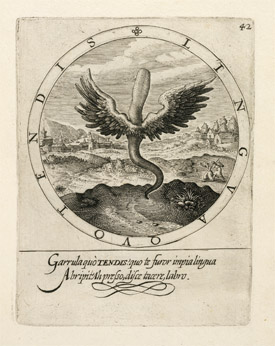Emblem Collection

|
|
From the ancient Greek en/bléma, literally 'struck in,' illustrated emblem books were intended to make an impact on one's memory. The term was first coined by the Milanese jurist Andrea Alciati (Italian, 1492–1550), whose Emblematum libellus (Little book of emblems; Augsburg, 1531) is credited with the invention of this genre. Such illustrated books continued to be enormously popular throughout Europe at least until the end of the eighteenth century.
The layout of an emblem-book page usually consists of three parts: motto, emblem (image), and epigram (accompanying poem). The emblematic artist was encouraged to create the most unusual image possible in order to make the strongest impact on the reader's memory. The interaction of bizarre allegorical imagery with moralizing mottoes and poetry became the source of some of the most creative artistic uses of visual symbolism in early modern Europe.
The emblematic formula was applied to any number of early modern subjects. Through their imagery, Christian morality was reinforced, ancient fables were memorized, elementary legal terms clarified, famous academics immortalized, and arcane scientific notions popularized. Increasingly, as the art of the emblem book evolved, artists employed them as dictionaries of allegory and iconography, transforming the symbolic language of the visual arts.
The Research Institute holds one of the world's leading collections of emblem books, many of which have been digitized.
The layout of an emblem-book page usually consists of three parts: motto, emblem (image), and epigram (accompanying poem). The emblematic artist was encouraged to create the most unusual image possible in order to make the strongest impact on the reader's memory. The interaction of bizarre allegorical imagery with moralizing mottoes and poetry became the source of some of the most creative artistic uses of visual symbolism in early modern Europe.
The emblematic formula was applied to any number of early modern subjects. Through their imagery, Christian morality was reinforced, ancient fables were memorized, elementary legal terms clarified, famous academics immortalized, and arcane scientific notions popularized. Increasingly, as the art of the emblem book evolved, artists employed them as dictionaries of allegory and iconography, transforming the symbolic language of the visual arts.
The Research Institute holds one of the world's leading collections of emblem books, many of which have been digitized.
